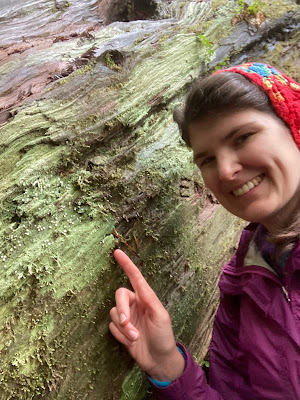As part of my PhD project studying the lichen family Psoraceae, Einar and I (Annie) traveled to California in March for field collecting, visiting lichen collections, and joining the Northwest Lichenologists and California Lichen Society meeting. The trip was funded by the Peder Sather Grant at the University of California, Berkeley.
 |
| Klara and Einar at the UC Berkeley Lichen Collection. |
First, we visited our collaborators Dr. Klara Scharnagl and Dr. Brent Mishler (not pictured) at UC Berkeley. Klara is the Tucker Curator of Lichenology for the collections. She helped us look through the collections for relevant specimens for the project.
 |
Psora sp. specimen at UC Berkeley.
|
 |
| Einar curating the Psora specimens. |
After a couple of days in Berkeley, we drove up to Arcata, California for the field meeting.
 |
| We pulled over to look for Carbonicola anthracophila on the way. |
The first day of the Northwest Lichenologists Meeting included presentations. I presented on my project with
Psora and Einar presented on "Species hypotheses in
Lecidea and
Porpidia based on DNA barcode markers".
 |
| Einar presenting on Lecidea. |
The first day of the meeting also included a field excursion to Bald Mountain.
 |
| First field day with CALS and the Northwest Lichenologists. |
 |
| Einar collected some crustose lichens for the Lecidea and Rhizocarpon projects. |
The second day of the meeting included a field excursion to Samoa Dunes and Wetlands.
 |
Ramalina menziesii was common at the Dunes.
|
The third day, instead of Horse Mountain, we visited the Prairie Creek Redwoods State Park.
 |
| Trillium ovatum, Pacific Trillium |
Annie with fairy puke lichen.
 |
Icmadophila ericetorum, Fairy Puke |
 |
| Bus Stop lichens, including Lichenomphalia umbellifera |
At the end of the last day, there was a potluck dinner with the California Lichen Society.
 |
| Klara presenting at the CALS dinner. |
After the dinner, there was jam session with a few of the CALS members, including Allie Weill who preformed her song The
Age of Enlichenment.














































